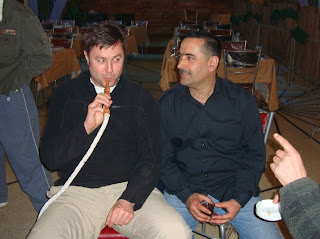The PlaceWhile in al-Hasakah we have been hosted by the Ministry of Agriculture and Environment in an apartment. Pomegranate trees outside, three bedrooms, squat toilet and comfy living room.
 Courtyard
Courtyard  Hywell eyes up chillies
Hywell eyes up chillies
Fantastic food!
KidsWe are always the star attraction in town. Some really cheeky kids. Handed out pens and badges to them as well as taking their pics and showing them on the back of the camera.
 The audience
The audience Ace guy who we all really like. He certainly has the patter and the swagger though and is a real character. He is a member of SSCW but works for the Ministry and has been with us on a few days in the field. He likes a bit of banter and I think is very proud to be seen out and about with us. He has arranged our meetings, the mosque etc. He even talked me into trying the hubble bubble (a smoking machine with cool fragrant tobacco -double apple flavour- definitely NOT my thing) despite his English being on a par with my Arabic. Then there is Mohammed 2…….

Mohammed 1 showing me the ropes
Hubble Bubble time
Where ever we go out here the Hubble Bubble can be seen. In Damascus the first restaurant we walked into everyone was puffing away – no smoking bans in Syria that’s for sure. Even the ladies were getting stuck in which was quite a surprise.
Eventually the Syrians have persuaded all of us to have a go. They are designed apparently to cool the smoke so it is smoother than a normal cigarette. The tobacco that goes in is fragranced. Strawberry was grim, and double apple (the most popular) wasn’t that great either. You rent them out in the cafes and the staff come and pop hot coals onto the tobacco to keep it burning. You then have to drag heavily to get the smoke to flow down the long hose like pipe.
Not one that will catch on in Stornoway I suspect.
 The double whammy
The double whammy For the drive out to the desert this morning I got the MP3 player out for the first time. The Proclaimers seemed a good choice – even Yassen got into them and picked up some more Scottish phrases. Maybe Craig and Charlie need a Syrian tour!
Al-JazeriaNot just an Arabic TV station. The past week has been spent surveying it, or at least its northern fringe. The literal translation means ‘the island’ as this patch of northern desert is road free and isolated. Dusty, stony, dry, cracked, harsh, arid, barren, sparse, sandy, hot, windy, acrid. That’s the Al-Jazeria.
 Our convoy in a sandstorm
Our convoy in a sandstorm  Scanning for Sociables
Scanning for Sociables
 Trucking in the desert
Trucking in the desert